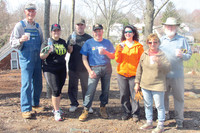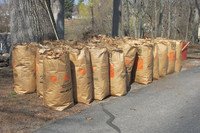

The Johnston Historical Society cemetery crew that participated in Saturday’s statewide Rhode Island Cemetery Clean-up Day was relatively small, but its results were extra large.
Seven members, headed by Chairman Steve Merolla, worked tirelessly for some three hours and turned the once-debris filled Historical Cemetery #44 into a respectable resting place for those who are buried on the same property that serves as headquarters for the award-winning veteran’s organization known as Operation Stand Down at 1010 Hartford Avenue in Johnston.
“We filled 45 huge bags with broken branches, leaves, etc.,” Merolla reported. “The place was a mess; now, it looks presentable and people can actually see the 80 or so burials.”
However, as Merolla further explained, only three of the gravestones are marked or inscribed slate stones, which is – he pointed out – “quite unusual seeing is that the unmarked sites are crude stones.”
“This is a large cemetery,” Merolla noted. “This was a successful day and our volunteers cleaned it from end-to-end and we had so many bags we needed the super people at the Johnston DPW (Department of Public Works) to help us remove the bags.”
And, as Merolla also noted about the JHS Cemetery Committee’s on-going cleanp0up efforts, “you never know what you might find once a clean-up is completed.”
For example, a few years back, a local resident found the small slate stone of Henry A. Caesar, a child of one year and 10 months, who died in 1843. The stone was found to the side of Borden Avenue. The finder contacted the JHS that took possession of the stone.
“Not knowing exactly where the stone was originally located,” Merolla explained. “We then decided to re-set it next to that of his sister, Harriet F. Caesar, a 2-year-old who died in 1849.”
Saturday, JHS recording secretary Elise Carlson made a huge discovery – make that two – inside Cemetery #44.
“For many years we had made note of the small foot stone of Annjemima Daily – whose maiden name was Caesar – but we never located the head stone,” said Merolla. “Elise took an interest in part of a stone we raked over; the stone was turned over and over and lo and behold it was the headstone of Annjemima Daily, buried upside down for at least 20 years.”
The group found that extremely interesting because most of the stones are unmarked crude stones; just small rounded stones without any writing or inscriptions.
Carlson, meanwhile, said what she thought was siring on a side of the stone and sure enough the year “1818” was chiseled into the stone. There is a name, but neither of the JHS members present said it couldn’t be deciphered.
“This crudely chiseled stone is one of only a handful of its type in town and that was not professionally carved into slate or marble, but carved most likely by a family member back then,” Merolla concluded.
Comments
No comments on this item Please log in to comment by clicking here